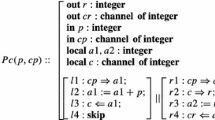Abstract
A basic question in the theory of communicating processes is “When should two processes be considered equivalent?”. Attempts to answer this question have led to the concepts of observation equivalence, bisimulations, testing equivalence, failure equivalence, etc. The main point of this paper is to increase the understanding and motivation for two of these equivalences, namely failure and testing equivalences. The approach starts with the idea that the equivalence of processes should be reducible to the visible sequences of actions which a process performs in various contexts. This idea is implemented by a string-based semantic order for communicating processes where divergence is catastrophic. Under some assumptions about contexts, the resulting semantics is shown to be equivalent to theimproved failure semantics of Brookes and Roscoe(1) and also to themust testing-semantics of Hennessy and DeNicola.(2–4) This characterization gives independent support for the appropriateness of failures and testing.
Similar content being viewed by others
References
S. D. Brookes and A. W. Roscoe, An Improved Failures Model for Communicating Processes, Carnegie-Mellon University Technical Report CMU-CS-85-112 (1985).
M. C. B. Hennessy, Synchronous and Asynchronous Experiments on Processes, Internal Report CSR-125-82, Department of Computer Science, University of Edinburgh, Scotland, (September 1982).
R. DeNicola, Testing Equivalences and Fully Abstract Models for Communicating Processes, Ph. D. Thesis, University of Edinburgh (November 1985).
R. DeNicola and M. C. B. Hennessy, Testing Equivalences for processes, in:Automata, Languages and Programming, 10th Colloquium, LNCS 154: Springer-Verlag, (1983); Expanded version inTheoretical Computer Science 34:83–133 (1984).
E. W. Dijkstra, Guarded Commands, Nondeterminacy and Formal Derivation of Programs,CACM 18:453–457 (1975).
M. Smyth, Powerdomains,Journal of Computer and System Sciences,16:23–36 (1978).
J. W. de Bakker J. A. Bergstra, J. W. Klop and J.-J. Ch. Meyer, Linear Time and Branching Time Semantics for Recursion with Merge,in: Automata, Languages and Programming, 10th Colloquium, LNCS 154:39–51 Springer-Verlag, (1983).
S. D. Brookes, On the Relationship of CCS and CSP, In:Automata, Languages and Programming, 10th Colloquium, LNCS 154:83–96 Springer-Verlag, (1983).
S. D. Brookes, A Model for Communicating Sequential Processes, Ph. D. Thesis, University of Oxford (1983).
M. Broy, Semantics of Communicating Processes,Information and Control,61:202–246 (1984).
A. Pnueli, Linear and Branching Structures in the Semantics and Logics of Reactive systems, in:Automata, Languages and Programming, 10th Colloquium, LNCS 154:15–32.
W. C. Rounds and S. D. Brookes, Possible Futures, Acceptances, Refusals and Communicating Processes, in:22nd IEEE Symposium on Foundations of Computer Science (1981).
S. D. Brookes, C. A. R. Hoare, and A. W. Roscoe, A Theory of Communicating Sequential Processes.JACM 31:560–599 (1984).
R. Keller, Formal Verification of Parallel Programs,CACM 19:561–572 (1976).
R. Milner, ACalculus of Communicating Systems, LNCS Vol. 92 Springer-Verlag, (1980).
C. A. R. Hoare, Communicating Sequential Processes,CACM 21:666–677 (1978).
S. Abramsky, Observation Equivalence as a Testing Equivalence,Draft (November 1985).
S. D. Brookes, A. W. Roscoe, and D. J. Walker, An Operational Semantics for CSP, prepublication copy, (February 1987).
J. W. de Bakker, J.-J. Ch. Meyer and E.-R. Olderog, Infinite Streams and Finite Observations in the Semantics of Uniform Concurrency, In:12th ICALP, LNCS 194:149–157 Springer-Verlag, (1985).
M. C. B. Hennessy, Why Testing Equivalence is Natural, (prepublication copy) (August 4, 1987).
Author information
Authors and Affiliations
Additional information
This research has been supported in part by National Science Foundation grant DCR-8402341.
Rights and permissions
About this article
Cite this article
Main, M.G. Trace, failure and testing equivalences for communicating processes. Int J Parallel Prog 16, 383–400 (1987). https://doi.org/10.1007/BF01407903
Received:
Revised:
Issue Date:
DOI: https://doi.org/10.1007/BF01407903




